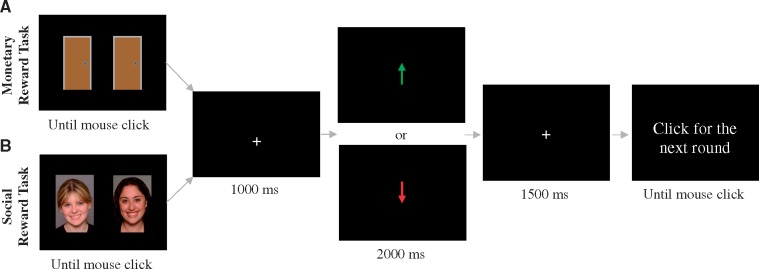Fig. 1.
In the monetary reward task, each trial began with the presentation of two identical doors. Participants were instructed to select the left or right door by clicking the left or right mouse button, respectively. Participants were told that they could either win $0.50 or lose $0.25 on each trial. These values were chosen in order to equalize the subjective value of the gains and losses (Tversky and Kahneman, 1981, 1992). The goal of the task was to guess which door contained the reward while attempting to earn as much money as possible. The image of the doors was presented until the participant made a selection. After stimulus offset, a fixation cross (+) was presented for 1000 ms, and then feedback was presented on the screen for 2000 ms. Correct selection of the rewarding door resulted in a monetary gain, indicated by a green arrow pointing upward (↑). Incorrect selection of the losing door resulted in a monetary loss, indicated by a red arrow pointing downward (↓). In actuality, feedback was pre-programmed to generate an equal number of gain and loss trials. The feedback stimulus was followed by a fixation cross presented for 1500 ms, immediately followed by the message ‘Click for next round’. This prompt remained on the screen until the participant responded with a button press to initiate the next trial. The social reward task was identical to the monetary reward task, except pictures of gender-matched peers (i.e. two male or two female faces) were presented instead of doors. Participants were instructed to select the individual they believed ‘liked’ them by clicking the left or right mouse button, respectively. Correct selection of the peer who purportedly provided ‘like’ feedback resulted in social acceptance, indicated by a green arrow pointing upward (↑). Incorrect selection of the peer who provided ‘dislike’ feedback resulted in social rejection, indicated by a red arrow pointing downward (↓). In actuality, feedback was pre-programmed to generate an equal number of acceptance and rejection trials.

